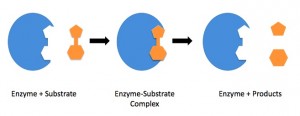We have heard about the role of catalysts in a chemical reaction. Catalysts are those substances that enhance the rate of a chemical reaction without themselves getting chemically modified. We also know that there are multiple reactions that take place inside our body. These bio-reactions that occur in our body during various life processes also require catalysts; the substances that act as biocatalysts for the reactions inside our body are called enzymes. They increase the rate of reaction by lowering the activation energy of the reaction. Enzymes are often referred to as the biological catalysts. The processes inside our body such as digestion of food, secretion of hormones, production of energy, etc. require enzymes.
Properties of Enzyme
Enzymes are normally named after the class of compound upon which they act or the specific reaction. Enzymes require very specific conditions for proper functioning. Also, they have this nature of being highly selective in their actions. They have specific roles and can catalyse only specific reactions. Most of the enzymes are proteins or derivatives. Similar to catalysts, they also don’t get modified and retain their characteristics after the reaction and hence can be used again.
Mechanism of Enzyme action
Enzyme activity is greatly affected by the conditions of the reaction; most enzymes require specific conditions of temperature and pH. Mechanism of enzyme action and their selectivity can be best explained by the lock and key model.
Enzyme provides the substrate a surface for the reaction to occur. The substrate forms a complex (intermediate) which then gives the product and the enzyme. The substrate that gets attached to the enzyme has a specific structure and can only fit in a particular enzyme similar to that of a lock which has a specific key. By providing a surface for the substrate, an enzyme brings down the activation energy of the reaction. The mechanism of enzyme action has been a matter of research ever since their identification.
Enzyme activity in biological system and their selective nature has lead to the development of many biological catalysts. Scientists are now working towards the synthesis of many artificial enzymes. The study of bio-reactions and their catalysts will serve as the base for creating wonders in the coming times. Join BYJU’S to learn more about this concept.





Comments